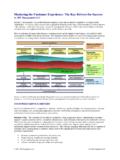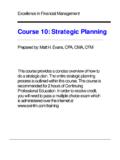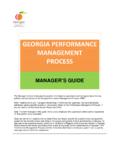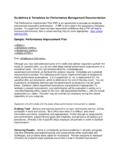Transcription of Performance Management: Impacts and Trends …
1 WhitepaperTo learn more, call your local DDI office or contact:The : Impacts and TrendsWritten and prepared by:Roger Sumlin, Senior ConsultantPerformance management PracticeRecent studies have identified Trends in effectiveperformance management systems and determinedthe impact of these systems on organizationalsuccess. The messages from these studies aredramatic: Performance management is an importantbusiness system; it makes a difference inorganizational Performance ; approaches toperformance management are changing; and seniormanagers must be attentive to the performancemanagement systems in their body of research is useful to anyone designingand implementing a new Performance managementsystem and equally beneficial to those trying toprove the value of effective paper reviews six recent performancemanagement studies and organizes their keyfindings into two groups: Performance Manage-ment Impact on Organizational Success andPerformance management Trends /Best first group substantiates the importance ofperformance management ; the latter group aids thepractitioner seeking the characteristics of successfulsystems.
2 Two studies, one by DDI in 1997 and oneby Hewitt in 1994, address and appear in bothareas organizational impact and management Impact onOrganizational Success1997 Study by DDIP erformance management Practices is the mostrecent Performance management study. It provesthat successful organizations realize thatperformance management is a critical business toolin translating strategy into results. The CEOs in themajority of the 88 organizations surveyed say theirperformance management system drives the keyfactors associated with both business and culturalstrategies. Some key findings of the study ImpactPerformance management systems directlyinfluence five critical organizational outcomes:financial Performance , productivity, product orservice quality, customer satisfaction, and employeejob DIMENSIONS INTERNATIONAL2 Performance ManagementWhen Performance management systems areflexible and linked to strategic goals, organizationsare more likely to see improvement in the fivecritical objectives, nonmanager training, appraiseraccountability, and links to quality management arethe specific practices most strongly associated withpositive Survey CEO RatingsA supplemental survey in this study sought CEOs'perceptions of their organizations' performancemanagement percent of CEOs believe theirperformance management system drives the keyfactors associated with business strategy.
3 Seventy-nine percent say their system drives the culturalstrategies that maximize human CEOs realize the value of performancemanagement in driving business strategy, overallsystem effectiveness is significantly success of Performance management and itseffect on business and cultural strategies dependheavily on senior-level Study by Wm. Schiemann & AssociatesThis national survey of a cross-section of executivesconcluded that measurement-managed companies especially those that measure employeeperformance outperform those that downplaymeasurement. The research studied 122organizations making between $27 million and$50 billion in higher percentage of measurement-managedcompanies were identified as industry leaders, asfinancially in the top third of their industry, and assuccessfully managing their change efforts.
4 Thislast area implies that measurement-managedcompanies tend to anticipate the future and arelikely to remain in a leadership position in a rapidlychanging research examined Performance in six strategicperformance areas deemed crucial to long-termsuccess: Financial Performance Operating efficiency Customer satisfaction Employee Performance Innovation/Change Community/EnvironmentThe findings revealed that the biggest measurementarea separating successful from less successful firmsis employee measurement. Successful industryleaders simply do a better job than nonleaders atmeasuring their workforce, which, the study says, iswhere real change is won or data point strongly to four mechanisms thatcontribute to the success of measurement-managedcompanies: Agreement on strategy.
5 Ninety-three percent ofthe measurement-managed firms reportedagreement among top management on strategy,versus only 37 percent of the nonmeasurement-managed organizations. Clarity of communication. Good communi-cation demands a clear message, andmeasurement provides a common languagefor DIMENSIONS INTERNATIONAL3 Performance management Focus and alignment of efforts. Measurement-managed companies reported more frequentlythat unit Performance measures were linked tostrategic company measures and that individualperformance measures were linked to unitmeasures. Organizational culture. Compared tononmeasurement-managed organizations,measurement-managed companies morefrequently reported strong cultural elements,such as cooperation and teamwork amongthe management team, a greater extent ofemployees self-monitoring their ownperformance, and a greater willingness totake Study by Yankelovich Partners forWilliam M.
6 MercerThe 1,200 workers surveyed said that on averagethey could improve their daily output by at least26 percent if only they weren't hindered by lackof in order of importance direction, support,training, and equipment. One in four said theycould raise productivity by 50 percent. An effectiveperformance management system delivers thedirection and support workers Study by Hewitt AssociatesThe Impact of Performance management onOrganizational Success substantiates thatperformance management systems can have asignificant impact on financial Performance andproductivity. The study used the Boston ConsultingGroup/HOLT financial database to track thefinancial Performance of 437 publicly held from 1990 through 1992.
7 Researchersfirst compared organizations that had performancemanagement systems with those in the sameindustry that did not. The researchers thencompared the financial Performance of theorganizations having Performance managementsystems (47 percent) to see how those organizationsfared before and after study results showed that: Companies with Performance managementprograms have higher profits, better cash flows,stronger stock market Performance , and agreater stock value than companies withoutperformance management . Productivity in firms without performancemanagement is significantly below the industryaverage, while productivity in firms withperformance management is on par with theindustry average.
8 Companies with Performance managementsignificantly improved their financialperformance and productivity afterimplementing Performance 1995 the researchers conducted additionalanalysis of the study data. This longitudinalresearch focused on the following three financialratios that the researchers say are excellentindicators of a company's overall financial strength: Stock return to market index Price to book total capital Real value to costCompanies with Performance management achievedhigher ratios than those without in all three DIMENSIONS INTERNATIONAL4 Performance ManagementPerformance management Trends /Best Practices1997 Study by DDIIn addition to looking at impact on organizationalsuccess as reported in the first section, this studyalso investigated organizations' current performancemanagement practices and compared the resultswith those from DDI's 1993 study (described later inthis paper).
9 Most Frequently Used Practices Fifty-one percent of organizations frequentlytrain managers in applying performancemanagement systems, and 22 percent frequentlytrain nonmanagers. Thirty-eight percent of the organizationsfrequently use competencies in theirperformance management systems. Approximately 20 25 percent of organizationsfrequently use peer input, customer feedback,and input from direct reports. Twenty percent of organizations frequentlyinclude team-based objectives in individualperformance plans. Team appraisal, in whichteam members or peers actually appraise oneanother, is less common. For rating techniques organizations relyprimarily on overall ratings, summarystatements, and numerical in UsageIn 1993 DDI's survey of Performance managementpractices measured current and predicted usage for12 of the practices measured in this study.
10 Thefollowing highlights the key changes in usagebetween the two studies: Training for both managers and nonmanagers inperformance management doubled in four years. Forced rankings ( , the use of a predeterminedpercentage of ratings distribution) decreased bymore than 300 percent since 1993. Team-based objectives have become morecommon. The most common rating tools overall ratingsand summary statements are used even morefrequently than they were four years previous. Different forms of Performance managementinput particularly peer input have becomemore common. Respondents to the 1993 survey predicted alarge increase in the use of team prediction proved to be off some system qualities such as employeeinvolvement and flexibility were more prevalent,they were not necessarily the qualities mostpredictive of system success.


















